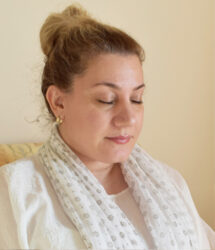Sharing Expressions of Inner Silence with my Parents

My discovery that there is a field of Being—a silent source of creativity, intelligence and bliss deep within human awareness and at the basis of all of existence—changed my life. Gaining this knowledge not only on the level of concept, but far more importantly, on an experiential level, has rewarded me with riches beyond measure.
Throughout time and space, spiritual persons who have fathomed this field themselves have sought to remind us of our potential, sometimes called “enlightenment.” To discover this possibility, as a young person seeking for something more than the dismal grip of the status quo, was the turning point in my life.
When I learned TM and began experiencing that silent source of creativity and joy, it felt familiar, like coming back home. Within this field of quietness, I felt I was reclaiming a part of myself that was utterly important, intimately intrinsic—my truest Self.
Most of us as small children had a sense of playful delight in the world and in ourselves. As we got older, we sensed our potential for greatness, and trusted that it would unfold in time. But that trust was dampened by the world in which we grew up—a world dominated by the physical. That worldview is now beginning to change, but for many of us, even with religious exposure, our worldview was materialistic—not only in the emphasis on having material things, but far more insidiously, the perspective that the physical world was the only reality. From almost every influence in school and in the media, we were taught that the concrete world of the senses was the only real one. Any experience other than this was met with suspicion. As the psychiatrist R.D. Laing wrote, “To adapt to this world the child abdicates its ecstasy,” quoting the French poet Malarme: L’enfant abdique son extase.
Throughout the ages, spiritual teachers, speaking from their experience, urge us to wake up, come out of the darkness into the light. Our essential nature is vast. We have the potential for an all time awareness of unshakeable peace, profound bliss, and attunement to natural law.
Many people who learn TM find renewed interest and insight into their own religious heritage. I and my parents, including my father—a Protestant minister—discovered this to be the case.
Whenever I visit my parents, I join in their morning routine of “readings, reflections, and reminiscences.’’ Drawing from spiritual sources from around the world, we enjoy finding expressions of development of consciousness. Recently my mother read from a Taoist writer:
Once you find deep solitude and calm, there will be a great gladness in your heart….There will be bliss, wonder, the awe of attaining something pure and sacred. (Deng Ming-Dao)
She commented upon how this was increasingly her own experience—not only in meditation, but in her activity.
Another time she read a well known verse from the Bible about the restorative power of silence …he leads me beside still waters, he restores my soul… (Psalm 23). She related this to the restorative rest she gained from her TM practice when she was teaching school. After a full day of teaching, she would find a quiet classroom in which to meditate. Afterwards she felt revitalized, ready to make the drive to tutor her Japanese students, who loved her for her creative enthusiasm and patient kindness.
My father related a verse from Isaiah: In returning and rest is your salvation; in quietness and trust is your strength (30:15). I asked him what he felt was the value of this “return” of which Isaiah speaks. He responded, “In so doing, we return to our sanity, to the inmost center of being human, to the mode of Being which God intended for human beings.” He referred to another psalm, Be still, and know that I am God (46:10).
My father continued, “We especially need this teaching today because we tend to get so distracted by a myriad of unimportant things. This is an issue one of my favorite contemporary theologians, Howard Thurman, wrote about: There is very great virtue in the cultivation of silence, and strength to be found in using it as a door to God. Such a door opens within.”
Another author we enjoy sharing is Henry David Thoreau.
In my better hours I am conscious of the influx of a serene and unquestionable wisdom…. What is that other kind of life to which I am thus continually allured? Which alone I love? …Are our serene moments…simply a transient realization of what might be the whole tenor of our lives?
Thoreau’s poignant question is one that so many people ask. And Maharishi’s response is that this serenity and inner wisdom can be the tenor of our whole life.
The Nature of the Self: SAT CHIT ANANDA
The above writers refer to the silent field of Being at the basis of life. Referring to the language of the Vedic tradition, Maharishi describes the nature of Being, or the Self. He explains, “Experience shows that Being is…Sat-Chit-Ananda—It is Sat, that which never changes; it is Chit, that which is consciousness; it is Ananda, that which is bliss…. Being is the basis of life, that which gives it meaning and makes it fruitful.”
This field of Being, our Self, experienced permanently in Cosmic Consciousness, is the source of all the laws of nature that govern the evolution of human life and the whole universe. It is the “home of all the laws of nature.” Maharishi, along with physicists such as Dr. John Hagelin, proposes that this unmanifest field of consciousness is one and the same field that physicists theorize as the underlying unified field of natural law.
As we experience this “home of all the laws of nature” within the most settled state of our awareness, we gain its evolutionary support. Our thoughts and action begin to be guided and upheld by natural law. We have life-supporting desires and decisions—nourishing to ourselves and others—with more powerful support for their fulfillment.
TM is simply, but so significantly, a natural and reliable way to access this inherent field of Being—providing us with this experience that has been treasured throughout time—the silent field of bliss, the home of all the laws of nature, giving our lives unshakeable joy, life-supporting direction, and creative intelligence to fulfill our desires.
References
R. D. Laing, from John White, ed. The Highest State of Consciousness, Anchor Press
Deng Ming-Dao, 365 Daily Meditations, Harper Collins
Rev. Roger Wm. Johnson, PhD and Cynthia E. Johnson, “Silence is the Universal Refuge,” Ch VII, from A Symphony of Silence by George Ellis. http://www.mumpress.com/books/other-authors/asos.html
Howard Thurman, Meditations of the Heart
Alan D. Hodder, Thoreau’s Ecstatic Witness, Yale University Press
Charles Alexander and Ellen Langer, editors. Higher Stages of Human Development: Perspectives on Adult Growth, Oxford University Press.
About the Author
Cynthia Johnson is a teacher of the Transcendental Meditation program. She holds a Master of Theological Studies from Harvard Divinity School and is a mother, wife and writer. She is a contributor to the book A Symphony of Silence: An Enlightened Vision (1st and 2nd editions) by George Ellis.





